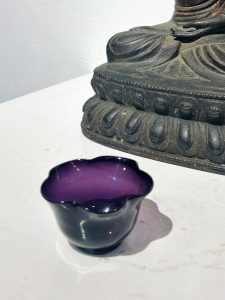江戸の粋を表す紫色(愛知県名古屋市千種区姫池通 骨董買取 古美術風光舎)
2024.11.06
皆さまこんにちは。スタッフHでございます。
本日は秋晴れのお散歩日和ですが、明日以降は強い寒気が南下し各地で今シーズン一番の冷え込みとなるようです。
今日のポカポカ陽気に包まれていますと実感が湧きませんが、急な気温変化で体調を崩されないようお気を付けください。
寒くなると暖かい部屋で読書など、と思いますが年々小さな文字を読むのに疲れを感じやすくなっています。視力がさらに衰える前に積んである本から読み始めてみようと思います。
さて、先日風光舎に仲間入りした江戸硝子、花びらのような形状がかわいいのですが、濃い紫色が落ち着いた雰囲気を醸し出しています。

「江戸切子」はよく耳にしますが、「江戸硝子」に切子紋様を施したものが江戸切子で江戸硝子の一つといわれています。江戸切子にはこの濃いむらさき色がよく使われているように思います。
江戸切子に使われるこの紫は「江戸紫」と呼ばれ、赤みが強い「京紫」に対して青味が濃いのが特徴だそうです。
江戸紫が誕生したのは江戸時代に武蔵野に広く自生していた「ムラサキ草」の根を原料に染めたことが名前の由来で、江戸紫は庶民の間で大流行したとされています。
江戸時代に江戸紫が流行した要因に歌舞伎が関係しているとか。歌舞伎の演目である「助六由縁江戸桜(すけろくゆかりのえどざくら)」で、主人公の助六が江戸紫の鉢巻きを締めており、当時のファッションリーダーの歌舞伎役者に憧れて着物の柄や色などを自分たちの生活に取り入れました。
江戸時代の歌舞伎は当時の最大の娯楽で、今でいうアイドルなどの「推し」のカラーを身に着けたいと思うのと通ずるものがありそうです。そのあたりは今も昔も変わらず、なぜか江戸時代の人々に親近感が湧いてしまいます。
ただ江戸の人々はこの江戸紫を着物全体に使うのではなく差し色として使うのが人気だったとか。江戸の人々の「粋」を感じますね。
日本最古の硝子は弥生時代の勾玉と言われていますが、その技術は一度衰退し、再び歴史に登場するのはポルトガル船が種子島に漂着した1543年頃とされています。ヨーロッパの国々との交流が始まり、ガラスの技法も日本へと伝わりました。
江戸時代初期にはビードロやギヤマンと呼ばれるガラスが登場します。ビードロはポルトガル語で硝子を表し、ギヤマンはオランダ語でダイヤモンドを意味する「ディアマント」が名前の由来とされています。
この頃のガラスは中国から伝わった鉛を使用し、全て手作業で作られていました。日本の技術や設備はまだ小規模で窯も小さく木炭を使っていたため小さな薄手の物しか作れなかったそうです。
その後明治中期からはソーダ石灰を使ったソーダガラスが登場し、様々な種類のガラス製品が作られるようになりました。
その中で江戸切子は江戸時代からの伝統を引き継ぎ、東京や千葉の一部でひとつひとつ手作りで生産され、多品種少量生産の中で技術を磨き、あらゆる形状の製品を作り出しました。
硝子を1400度の高温で溶かし水あめのような状態にし「宙吹き(ちゅうぶき)」「型吹き(かたぶき)」「押型」の3つの技法があり、どれも職人の手作業により作られています。
関東大震災や東京大空襲などで大きな被害をうけましたが、多くの工場が復興し今日まで「江戸硝子」の伝統を継承してきたとのことです。
この紫色の小さな江戸硝子、ただ愛らしいだけではないようです。
それでは、また次の機会に。
myself reading in a warm room, but as the years go by, I find it easier and easier to get tired of reading small print. The other day, Staff T introduced “One Hundred Years of Solitude,” which a friend of mine lent me, but I couldn’t finish reading it. It was an old version, so the letters were even smaller and I felt dizzy when I opened the page. I have no excuse for this, but I think I will start reading the books I have in my stack before my eyesight deteriorates further.
Edo glass, which recently joined the Fuhkosha, is cute with its petal-like shape, and its dark purple color creates a calm atmosphere.
Edo faceted glass is a type of Edo glass with a faceted pattern on it. I think this dark purple color is often used for Edo faceting.
This purple used in Edo faceting is called “Edo purple,” and is characterized by a deep blue tinge, as opposed to “Kyoto purple,” which has a strong reddish tinge.
The name “Edo purple” originated from the fact that it was dyed using the root of “Murasaki grass,” which grew wild widely in Musashino during the Edo period, and it is said that Edo purple became very popular among the common people.
Kabuki is said to have been a factor in the popularity of Edomurasaki during the Edo period. In the kabuki play “Sukeroku Yukari no Edozakura,” the main character Sukeroku wears an Edo purple pachimaki, and it is said that people adopted the patterns and colors of kimono into their own lives, admiring the kabuki actors who were the fashion leaders of the time.
Kabuki in the Edo period was the greatest entertainment of the time, and it seems to have something in common with today’s desire to wear the colors of “guesses” such as idols. This is the same today as it was in the past, and for some reason I feel a sense of affinity with the people of the Edo period.
However, it is said that people in the Edo period did not use this Edo purple color for the entire kimono, but rather used it as an accent color. I feel the “chic” of the Edo people.
The oldest glass in Japan is said to be the Yayoi period’s kagatama, but this technique declined once, and it is said to have reappeared in history around 1543, when Portuguese ships drifted ashore on Tanegashima Island. With the beginning of exchanges with European countries, glass techniques were also introduced to Japan.
In the early Edo period (1603-1867), glass called “beadoro” and “geaman” appeared. Vidro is the Portuguese word for glass, and the name “Guillaman” is derived from the Dutch word “Diamant,” meaning diamond.
At this time, glass was made entirely by hand using lead, which had been introduced from China. Japanese technology and equipment were still small-scale, and kilns were small and used charcoal, so only small, thin pieces could be made.
Later, in the mid-Meiji period, soda glass using soda lime was introduced, and various types of glass products began to be made.
Among them, Edo faceted glass inherited the tradition from the Edo period and was produced one by one by hand in parts of Tokyo and Chiba, refining the techniques and creating products of all shapes and sizes through high-mix, low-volume production.
Glass is melted at a high temperature of 1,400 degrees Celsius to a syrup-like state, and three techniques are used: “Chubuki”, “Katabuki”, and “Oshimata”, all of which are made by hand by craftsmen.
Although the glass was severely damaged by the Great Kanto Earthquake and the Tokyo Air Raid, many factories recovered and have continued to carry on the tradition of Edo glass to this day.
This little purple Edo glass seems to be more than just adorable.
So, I’ll see you next time.
*******************、
ご実家の整理やお片付けなどをされている方のご相談などが多くございます。
お片付けなどくれぐれもご無理のないようになさってくださいませ。
風光舎では古美術品や骨董品の他にも絵画や宝石、趣味のお品など様々なジャンルのものを買受しております。
お片付けをされていて、こういうものでもいいのかしらと迷われているものでも、どうぞお気軽にご相談下さいませ。
また風光舎は、出張買取も強化しております。ご近所はもちろん、愛知県内、岐阜県、三重県その他の県へも出張いたします。
まずは、お電話お待ちしております。
愛知県名古屋市千種区姫池通
骨董 買取【古美術 風光舎 名古屋店】
TEL052(734)8444
10:00-17:00 OPEN
#出張買取#骨董#古美術#骨董品#絵画#版画#茶道具#刀剣#彫刻

